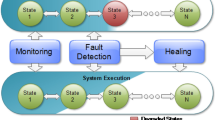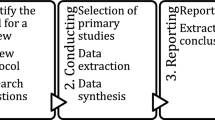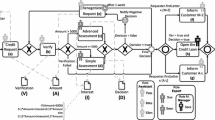Abstract
Configuration fragments developed separately and focusing on different aspects, such as availability, security or performance of a system need to be integrated into a consistent system configuration to avoid system malfunctions. The main challenges of such integration are due to the overlapping entities and the integration relations between the entities of the different configuration fragments. In this paper we propose a model based approach for a consistent integration of configuration fragments into a system configuration. We use and extend the model weaving technique to capture the semantics of the relations between the entities of the configuration fragments. Moreover, we generate automatically the constraints corresponding to these semantic relations to complete the target system configuration profile. These constraints can be used to guard the configuration consistency during runtime modifications.











Similar content being viewed by others
References
Bernstein, P.A. (2003). Applying model management to classical meta data problems. In: The conference on innovative data systems research (CIDR), Asilomar, California.
Del Fabro, M.D., & Valduriez, P. (2007). Semi-Automatic Model Integration using Matching Transformations and Weaving Models. In: ACM SAC, (pp. 963–970).
Del Fabro, M. D., & Valduriez, P. (2009). Towards the efficient development of model transformation using model weaving and matching transformations. Software and System Modeling (SOSYM), 8, 305–324.
Del Fabro, M.D., Bézivin, J., Jouault, F., & Valduriez, P. (2005a). Applying Generic Model Management to Data Mapping. In: Journées Bases de Données Avancés (BDA).
Del Fabro, M. D., Bézivin, J., Jouault, F., Breton, E., & Gueltas G. (2005b). AMW: A Generic Model Weaver. In: The 1ère Journée sur l’Ingénierie Dirigée par les Modèles.
Del Fabro, M.D., Bézivin, J., & Valduriez, P. (2006). Weaving models with the eclipse AMW plugin. In: Eclipse Modeling Symposium, Eclipse Summit Europe.
DMTF (2013). Standard, open virtualization format spec. Ver: 2.1.0. http://www.dmtf.org/sites/default/files/standards/documents/DSP0243_2.1.0.pdf.
Eclipse Atlas Model Weaver (AMW). (2010). http://www.eclipse.org/gmt/amw/.
Eclipse Modeling Framework, EMF. (2014). http://www.eclipse.org/emf.
Jahanbanifar, A., Khendek, F., & Toeroe, M. (2014). Providing Hardware Redundancy for Highly Available Services in Virtualized Environments. In: 8th IEEE International conference on Software Security and Reliability, Tokyo (SERE), (pp. 40–47).
Jahanbanifar, A., Khendek, F., and Toeroe, M. (2015a). Partial Validation of Configuration at Runtime, In: 18th Int. Symposium on Real-Time Distributed Computing, Auckland (pp. 288–291).
Jahanbanifar, A., Khendek, F., & Toeroe, M. (2015b). A Model-based Approach for the Integration of Configuration Fragments, Proceedings of the European Conference on Modeling Foundations and Applications (ECMFA), LNCS Vol. 9153, Springer, (pp. 125–136).
Jahanbanifar, A., Khendek, F., & Toeroe, M. (2016). Runtime configuration models adjustment for consistency preservation, in the IEEE HASE’2016 proceedings, Florida, January 07-09, 2016.
Jossic, A., Del Fabro, M.D., Lerat, J.P., Bezivin, J., & Jouault, F. (2007). Model Integration with Model Weaving: A Case Study in System Architecture. In: The International Conference on Systems Engineering and Modeling (ICSEM), IEEE CS Press, (pp. 79–84).
Jouault, F., & Bézivin, J. (2006). KM3: A DSL for Metamodel Specification. In: Formal Methods for Open Object-Based Distributed Systems (FMOODS 2006). Bologna, Italy LNCS, vol. 4037.
Jouault, F., Allilaire, F., Bézivin, J., & Kurtev, I. (2008). ATL: A model transformation tool. Science of Computer Programming, 72(1–2), 31–39.
Maedche, A., Motik, B., Silva, N., & Volz, R..(2002). MAFRA—AMApping FRAmework for Distributed Ontologies. In: 13th International Conference on Knowledge Engineering and Knowledge Management, Sigüenza (pp. 235–50).
Melnik, S., Rahm, E., & Bernstein, P. (2003). Rondo: A Programming Platform for Generic Model Management. In: SIGMOD conference, (pp. 193–204).
Nechypurenko, A. et al. (2007). Application of aspect-based modeling and weaving for complexity reduction in development of automotive distributed real-time embedded system. In: The proceedings of AOSD’2007, Vancouver.
Object Management Group. (2011). Unified Modeling Language – Superstructure Version 2.4.1, formal/2011–08-05, http://www.omg.org/spec/UML/2.4.1/.
Omelayenko, B. (2002). A Mapping Meta-Ontology for Business Integration. In: The workshop on knowledge transformation for the semantic Web (KTSW 2002) at the 15th European conference on artificial intelligence, Lyon, (pp. 76–83).
Reiter, T., Kapsammer, E., Retschitzegger, W., & Wimmer, M. (2005). Model integration through mega operations. In: Workshop on MDWE 2005.
Salehi, P., Hamou-Lhadj, A., Colombo, P., Khendek, F., & Toeroe, M. (2010). A UML-Based Domain Specific Modeling Language for the Availability Management Framework. In: 12th IEEE International High Assurance Systems Engineering Symposium, (pp. 35–44).
Service Availability Forum. (2010a). http://www.saforum.org.
Service Availability Forum. (2010b) Availability Management Framework, http://www.saforum.org/HOA/assn16627/images/SAI-AIS-AMF-B.04.01.pdf.
Service Availability Forum (2010c) Platform Management Service, http://www.saforum.org/HOA/assn16627/images/SAI-AIS-PLM-A.01.02.pdf.
Spaccapietra, S., & Parent, C. (1994). View integration: a step forward in solving structural conflicts. In: IEEE Transactions on Data and Knowledge Engineering, 6(2): 258–274.
Tisi, M., Jouault, F., Fraternali, P., Ceri, S., & Bézivin, J. (2009). On the use of higher-order model transformations. In R. F. Paige, A. Hartman, & A. Rensink (Eds.), ECMDA-FA 2009. LNCS (Vol. vol. 5562). Berlin: Springer.
Toeroe, M., & Tam, F. (2012). Service availability: principles and practice. New York: Wiley and Sons.
Acknowledgment
This work has been partially supported by Natural Sciences and Engineering Research Council of Canada (NSERC) and Ericsson.
Author information
Authors and Affiliations
Corresponding author
Rights and permissions
About this article
Cite this article
Jahanbanifar, A., Khendek, F. & Toeroe, M. Semantic weaving of configuration fragments into a consistent system configuration. Inf Syst Front 18, 891–908 (2016). https://doi.org/10.1007/s10796-016-9663-9
Published:
Issue Date:
DOI: https://doi.org/10.1007/s10796-016-9663-9




